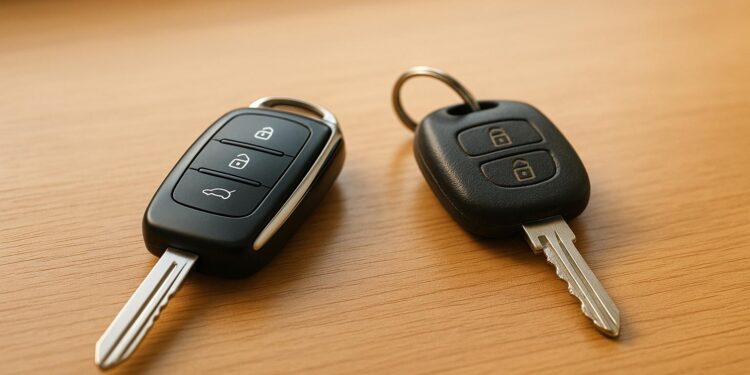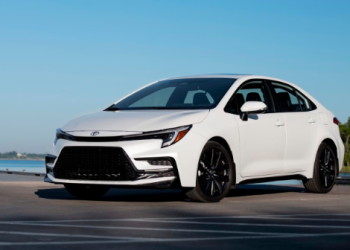When deciding between a new or used car, the down payment you make can significantly impact your overall costs. Here’s a quick breakdown:
- New Cars: Typically require a smaller percentage for a down payment, often supported by dealer promotions. They offer longer loan terms and lower interest rates, which can make monthly payments more manageable.
- Used Cars: Require a higher percentage upfront because lenders see them as riskier. Loans for used cars often come with shorter terms and higher interest rates, leading to higher monthly payments.
Key Takeaway: New cars may have higher sticker prices but often come with better financing options. Used cars may seem cheaper upfront but often require a larger down payment and higher monthly costs due to stricter loan conditions.
Quick Comparison
| Factor | New Cars | Used Cars |
|---|---|---|
| Down Payment | Lower percentage, often with promos | Higher percentage upfront |
| Loan Terms | Longer terms, smaller monthly payments | Shorter terms, higher monthly payments |
| Interest Rates | Lower due to less risk | Higher due to perceived risk |
Understanding these differences can help you plan your budget and choose the best option for your needs.
How Much Should Your Down Payment Be On Your New Or Used Truck?
Down Payment Requirements for New Cars
When you’re buying a new car, understanding how down payments work is crucial. They directly influence your monthly payments and the total cost of the loan. If you have strong credit and a steady income, you’re more likely to qualify for better financing terms. Let’s look at common down payment percentages, the factors that impact them, and what to know about loan terms for new car purchases.
Typical Down Payment Percentages
For new cars, down payment requirements are often on the lower side compared to used vehicles. Some dealerships even run promotions offering low or no-down payment options, though these deals usually come with specific eligibility criteria.
Factors That Affect New Car Down Payments
Several elements can influence how much you’ll need to put down:
- Credit history: A solid credit score can reduce your required down payment.
- Vehicle price: Higher-priced cars often demand a larger upfront payment.
- Dealership policies: Each dealership has its own rules and promotions.
- Debt-to-income ratio: If your debt levels are high compared to your income, you may need to pay more upfront.
Loan Terms for New Cars
New car loans often come with attractive interest rates, flexible repayment periods, and perks like manufacturer incentives or cash rebates. While longer loan terms can make monthly payments more affordable, they usually result in paying more interest over time. On the other hand, shorter terms help minimize interest costs but come with higher monthly payments. It’s worth comparing different options to find what works best for your budget.
Down Payment Requirements for Used Cars
When you’re in the market for a used car, you might notice that down payment requirements tend to be stricter compared to buying a new car. This is because lenders see used cars as riskier investments. As a result, they often ask for a larger upfront payment and offer less flexible financing options. This higher perceived risk directly impacts how much you’ll need to put down.
Why Used Cars Require Higher Down Payments
The down payment for used cars is often higher because these vehicles have already depreciated in value. How much you’ll need to put down depends on several factors, including the car’s age, mileage, condition, and your credit score. For instance, older cars or those with high mileage usually require a bigger down payment. On the other hand, if the car is in great shape, you might qualify for a smaller upfront payment.
Shorter Loan Terms and Higher Interest Rates
Financing a used car typically comes with shorter loan terms and higher interest rates. These tighter terms can lead to higher monthly payments, making a larger down payment even more critical to keep costs manageable. Lenders impose these conditions to protect themselves from the risks tied to financing a car that has already lost a significant portion of its value.
Depreciation and Added Risk
Used cars come with the added challenge of further depreciation. To safeguard against potential losses, like mechanical problems or poor maintenance history, lenders often require a larger down payment. Issues such as accident history or inconsistent upkeep can increase the lender’s risk, prompting them to insist on a higher upfront investment. This ensures the loan amount remains within a safe range relative to the car’s current market value.
New vs. Used Car Down Payment Comparison
When deciding between a new or used car, understanding how down payment requirements differ can help you make smarter financing choices. Lenders and manufacturers often tailor their terms based on whether the vehicle is new or pre-owned.
Key Differences in Down Payment Requirements
New cars generally come with more flexible financing options. Many lenders offer the possibility of a lower down payment, often supported by manufacturer incentives or special promotional deals. On the other hand, used cars typically require a larger upfront payment. This higher percentage helps lenders mitigate the risks associated with financing a pre-owned vehicle.
Another difference lies in loan terms. New car loans usually extend over longer periods, which can make monthly payments more manageable. Used car financing, however, often comes with shorter repayment terms, potentially resulting in higher monthly payments. Interest rates also tend to favor new cars, as lenders perceive them as less risky. The table below breaks down these key contrasts for a clearer picture.
Comparison Table: New vs. Used Cars
| Factor | New Cars | Used Cars |
|---|---|---|
| Down Payment Flexibility | Lower upfront payment options, often backed by promotions | Higher upfront payment typically required |
| Loan Terms | Longer terms, leading to smaller monthly payments | Shorter terms, which may increase monthly payments |
| Interest Rates | Generally lower and more competitive | Often higher due to increased risk |
When weighing your options, keep in mind that new cars often come with financing perks like lower down payments, longer loan durations, and better interest rates, all of which can help control your monthly budget. On the flip side, while used cars may have a lower purchase price, they often require a larger initial investment and shorter loan terms, which could lead to higher monthly costs.
sbb-itb-7bc66b5
What Affects Down Payment Amounts
When it comes to financing a vehicle, the amount you’ll need for a down payment isn’t set in stone. It’s shaped by a mix of factors, including the type of vehicle, your financial profile, and even market trends. Understanding these influences can help you plan ahead and negotiate better terms with lenders.
Vehicle-Related Factors
The price of the vehicle is a big determinant – higher-priced cars typically require larger down payments. But it doesn’t stop there. A car’s age also plays a role. Newer vehicles often qualify for better financing terms because they tend to hold their value longer compared to older models. On the other hand, a car’s condition – things like mileage and maintenance history – can directly impact the lender’s perception of risk, which may affect how much they ask for upfront.
Market demand is another element to consider. Cars that are in high demand or have a reputation for retaining value often come with more favorable financing options. Meanwhile, vehicles with a weaker market outlook might require a heftier down payment. Beyond the vehicle itself, your financial situation is equally important.
Buyer and Lender Factors
Lenders look closely at your credit history and income when determining how much you’ll need to put down. A strong credit score can work in your favor, potentially reducing the required down payment. On the flip side, if your credit history is limited or less than ideal, you might be asked to pay more upfront. Steady income and overall financial stability can also make lenders more comfortable, leading to more favorable terms.
Another factor to keep in mind is the loan-to-value (LTV) ratio. Lenders usually finance a significant portion of the car’s value, but they’ll expect you to cover the gap with a down payment. Individual lender policies can vary widely, so shopping around could help you find more flexible terms.
Special Financing Offers and Market Trends
Sometimes, promotions or shifts in the market can work in your favor. For instance, manufacturers or dealerships might offer special financing deals with low or even zero down payment options to drive sales. Broader market trends also play a role. The growing interest in electric vehicles, for example, has led to adjustments in financing terms for these models. Additionally, trade-in values and economic conditions can influence how much cash you’ll need upfront.
Down Payments for Car Buyers in Rwanda
Rwanda’s car market is evolving rapidly, shaped by the growing interest in electric vehicles and shifting financing options. Understanding these local trends can help you make smarter decisions when financing your next car.
Down Payments in Rwanda’s Car Market
Down payment amounts in Rwanda can vary widely, depending on the lender and the type of vehicle you’re purchasing. Tools like AUTO24.rw‘s Car Loan Calculator make it easier to explore different loan options and find one that suits your needs.
Imported vehicles also play a big role in shaping financing terms. Cars brought in from countries like South Korea, Canada, or the USA often come with unique requirements. Adding to the mix, electric vehicles are becoming a larger part of the market. For example, AUTO24 is set to launch an Electric Vehicle Swap Initiative in Rwanda in February 2024, signaling a shift in financing options and vehicle availability.
Whether you’re looking at a brand-new car or a pre-owned one, the specifics of Rwanda’s market can significantly influence your down payment strategy. Fortunately, there are resources designed to help buyers navigate these nuances with confidence.
Resources for Rwandan Car Buyers
If you’re buying a car in Rwanda, AutoMag.RW is a go-to source for essential insights. This platform covers everything from financing options and market trends to regulatory updates that could impact your down payment decisions. Through its collaboration with AUTO24.rw, AutoMag.RW offers access to a wide range of vehicles, including both traditional gas-powered models and electric vehicles.
For those considering imported cars, AutoMag.RW provides detailed guides to help you understand the different financing implications based on the country of origin. The platform also keeps buyers informed about key developments, such as Rwanda’s tax reforms on electric vehicles and the expansion of charging infrastructure – factors that can affect both ownership costs and financing terms.
On the practical side, AUTO24.rw offers tools like the Car Loan Calculator, which can help you estimate your monthly payments and figure out the down payment that’s right for your budget. Whether you’re leaning toward a conventional gasoline car or exploring Rwanda’s growing electric vehicle market, these resources offer the expertise you need to navigate your financing options with ease.
Conclusion and Key Takeaways
Summary of Key Differences
When deciding between a new or used car, your choice directly affects your down payment and financing options. New cars often come with lower down payment percentages and longer loan terms, making them more accessible in some cases. On the other hand, used cars typically require a higher upfront payment because lenders view them as a greater risk. Additionally, the age and condition of a used car play a big role – older vehicles or those with significant mileage might come with stricter loan requirements.
These differences highlight the need to tailor your financing strategy to the type of car you’re purchasing.
Final Advice for Buyers
Given these considerations, it’s essential to align your down payment approach with your financial goals and the realities of your local market. Start by calculating your full budget, including not just the down payment and monthly installments, but also insurance and maintenance costs.
For buyers in places like Rwanda, take advantage of local tools and resources to make informed choices. For instance, the AUTO24.rw Car Loan Calculator can help you experiment with different down payment scenarios and understand how they impact monthly payments. If you’re eyeing an imported vehicle, don’t forget to account for registration taxes and import duties – these extra expenses can significantly affect your overall financing needs and the ideal down payment amount.
If you’re leaning toward a used car, consider certified pre-owned programs. These often come with benefits like thorough inspections, refund policies, and mechanical warranties, which can ease lender concerns and potentially lead to better financing terms.
Finally, while it might be tempting to stick to the minimum required down payment, putting down more upfront can save you money in the long run by reducing the interest you’ll pay over time. However, a smaller down payment might make sense if you need to keep cash on hand for other priorities or emergencies. Take a close look at your finances and shop around to find the best terms for your situation.
FAQs
Why do lenders require higher down payments for used cars compared to new ones?
Lenders often ask for higher down payments when financing used cars because these vehicles come with more financial risks. Used cars are more likely to have mechanical problems, their maintenance history can be unclear, and they tend to lose value faster than new cars.
By requiring a bigger down payment, lenders minimize their risk. It acts as a buffer if the car’s value declines or if the borrower fails to make payments. Plus, it ensures the buyer has a greater financial commitment to the purchase, which lowers the lender’s exposure.
How do my credit score and finances impact the down payment and loan terms for a new or used car?
Your credit score and overall financial health play a key role in shaping your car-buying experience, especially when it comes to your down payment and loan terms. If you have a strong credit score, you’re more likely to qualify for lower interest rates and might even face a smaller down payment. This can make your purchase easier on your wallet.
However, if your credit score is on the lower side, you could encounter higher interest rates, a bigger down payment, and less favorable loan conditions.
Taking the time to evaluate your financial situation before diving into the car-buying process can make a big difference. It allows you to plan ahead, reduce surprises, and ensure a smoother experience overall.
How can I reduce financing costs when deciding between a new or used car?
To keep your financing costs in check, consider starting with a larger down payment. This approach reduces the loan amount, which can lead to lower monthly payments and less interest over the life of the loan. It’s also a good idea to compare interest rates for both new and used cars, as loans for used vehicles often come with higher rates. Opting for a shorter loan term can further help you save money by reducing the total interest paid.
Make sure to review your credit score before applying for financing. A strong credit score can open the door to better loan terms. If a used car is on your radar, take the time to confirm it’s in good condition. Unexpected repair bills could quickly eat into any savings you might gain from choosing a pre-owned vehicle.
Related Blog Posts
- Top 7 Tips for Choosing Between New and Used Cars
- Used vs. New Compact Cars: What First-Time Buyers Should Know
- New vs. Used Car Loan Rates in Rwanda





